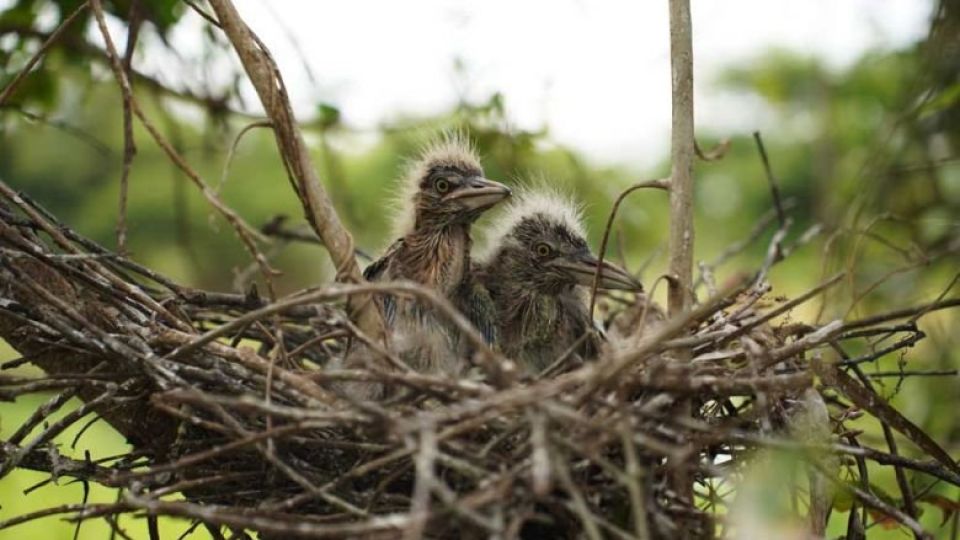October 5, 2023
PHNOM PENH – In Veal Thlan village – within Dangkor district’s Kong Noy commune, on the outskirts of Phnom Penh – a 4ha plot of privately owned land has remained vacant for years.
It has become a refuge of sorts for various bird species, including egret, heron, black-crowned night herons and painted storks, which are preserved by villagers and the local authorities.
Som Sarun, a local resident, said that in recent years, bird populations have noticeably increased. Around 10 families in the area have united to protect them from threats like habitat destruction and poaching.
“There have never been any poachers here because the community is united to protect the birds. When the birds are frightened, the villagers come together to deter any potential threats,” Sarun explained.
During a visit to the area, The Post met Suon Ry, a teacher at the Secondary School of Fine Arts, who was also viewing the birds there. He said that prior to his visit, like most people, he always thought that such areas only existed in distant provinces and never expected to discover such an enchanting place right within Phnom Penh.
“I enjoy cycling and exploring new sights. I will lead my friends to view these birds again, as every weekend our cycling group embarks on journeys to various sites, including forested areas that are home to a variety of species. I personally love nature and wildlife very much,” he said.
Ry believes that the birds enhance the natural landscape for visitors. He said hunters should refrain from such activities and join in preserving them.
“This area has the potential to become a tourist destination, drawing visitors to explore it. After witnessing the richness of birdlife here, I feel inspired to share it on social media and with my friends, both locally and globally, encouraging them to visit,” he added.
Meth Bunthoeun, a Kong Noy commune official who oversees the birds in the village, reported that in five or six years ago, the bird population was just 2,000 to 3,000, but the current count has surged to approximately 10,000.
He described the land as hilly, noting that it contains two or three graveyards. Surrounding the hill is a former paddy field which has been transformed into ponds by sand pumping activities. Over time, a bamboo forest and other trees have grown on the hill, providing ideal shelter for the birds. The birds occupy about 3 hectares of a 4-hectare plot, drawn to the area due to the presence of ample water and forested spaces.
He said the Department of Environment of Phnom Penh and Dangkor district regularly inspect the birds’ habitat.
“Upon entering the forest, you’ll notice an unpleasant smell due to the sheer number of birds. These birds consume fish exclusively. They bring it back to nourish their young, which leads to a pervasive fishy odour in the area,” he said.
He explained that black-crowned night herons hunt for fish in the evening. In contrast, painted storks search for food in the morning and return to their communal roosts in the evening. They nest in large groups, with 50 to 100 birds per tree.
Un Sarum, chief of Kong Noy commune, highlighted the village’s role as a nesting site for birds, as the area offers an ideal habitat for species to thrive and find refuge. While the bird’s habitat lies within the commune’s jurisdiction, the land itself is privately owned.
“As far as I’m aware, one of the landowners resides in France, and the other is in Cambodia. The birds have made this area their home since 2015 and are thriving,” he said.
“We are putting in considerable effort to preserve the space. I’ve contacted the police, requesting their assistance in safeguarding the bird sanctuary. I’ve also deployed two teams from the commune to monitor and protect the area,” he added.
Heang Nhor, deputy head of the district environment office, described the spectacle of thousands of birds returning to their shelter every night.
“In the past, Keat Rainsey, director of the Phnom Penh Environment Department, and I visited the area to assess the birds’ condition and identify required conservation measures. However, our efforts hinge on the Ministry of Environment’s decision,” he said.
“During the visit, Rainsey appraised the site and indicated that he would report it to the ministry, which will determine whether to maintain the area as a preservation zone or take other actions,” he added.
Phay Bunchhoeun, ministry spokesperson, explained that the ministry is awaiting further information and discussions with the landowners.
Chen Sophal, project manager of the Cambodia Bird Guide Association (CBGA), told The Post on October 2 that changes in habitat may explain the presence of the birds, which were previously considered rare in the area. Their increasing population is a positive development, possibly influenced by factors like climate change or habitat loss, which can drive birds to seek new homes.
“Even though these species are common, they still require protection and conservation. Ensuring their long-term survival necessitates the participation of both the community and local authorities,” he said.


